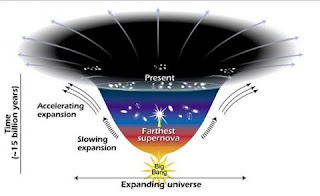Week 4 - the rate of rotation of galaxies.
Another major piece of evidence is the fact the inner and outer parts of galaxies appear to rotate at the same rate. This does not make sense, on the basis of calculations of the gravitational force from the stars and dust clouds that are visible in galaxies.
Use your understanding of circular motion to show how angular velocity of a star, around the centre of a galaxy, should depend on the distance from the centre of the galaxy. (Assume that the mass of the galaxy acts as if concentrated at the centre).
Post your conclusions, together with comments on what distribution of matter would explain observations.

Circular motion is a movement of an object along the circumference of a circle or rotation along a circular path and so the outer parts of the galaxy show theoretically be moving fast around the center than the inner section however if the mass of the outer area is less than that of the inner portion of the galaxy then the inner and outer parts could move with the at the same speed around the center however they would sty in line as it were if this is the case.
ReplyDeleteThe term circular motion relates to the movement of an object along the circumference of a circle or rotation along a circular path.
ReplyDeleteCircular motion is a movement of an object along the circumference of a circle or rotation along a circular path. for example the moon orbiting the earth, the earth being the center of origin with the gravity that pulls the moon towards us and the moons mass repelling and drifting off into space. therefore the moon will continue to orbit the earth. meanwhile it must have a certain velocity in order to travel but due to its continuous change in direction then its velocity if continuously changing. this means that if the velocity is always changing it must be accelerating. furthermore the further away a star is from the point of origin then the greater the angle in change of direction. therefore, theoretically, its acceleration will be greater then a star that is closer to the center of origin. this applies to the stars in the outer and inner parts of the galaxy. however if the mass of the outer parts of the galaxy are less then the inner parts of the galaxy then the inner parts will have less mass to carry and therefore will have a greater velocity. therefore will the difference in change of direction cancel with the difference in mass?
ReplyDeleteThe angular velocity depending on distance of a star orbiting the centre of a galaxy should match that of a moon orbiting a planet, meaning it should have a lower angular velocity the further it is away from the planet/centre of galaxy, but this is only true for the planet and moon because most of the mass is concentrated in the centre of the planet. This is not true for stars orbiting galaxies as stars revolve around their galaxy's centre at equal or increasing speeds over a large range of distances, but this does match their mass-distributions and so there is a 'missing mass' that scientists are using the theory of dark matter to try and explain why their velocity observations do not match the amount of mass that there is perceived to be by scientists using the distribution of stars in spirals and mass-to-light ratios.
ReplyDelete